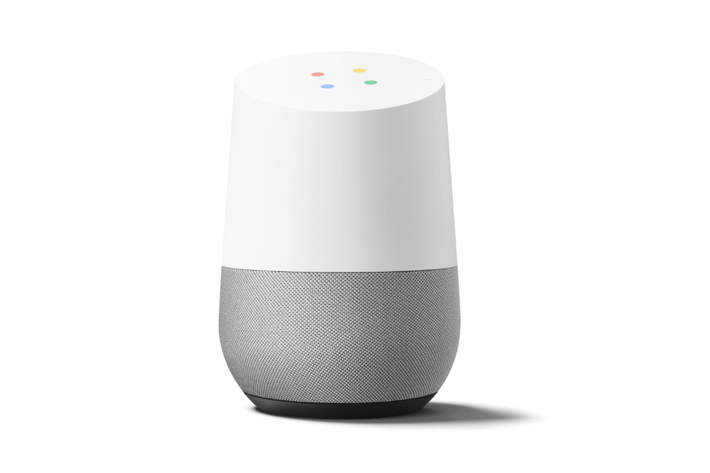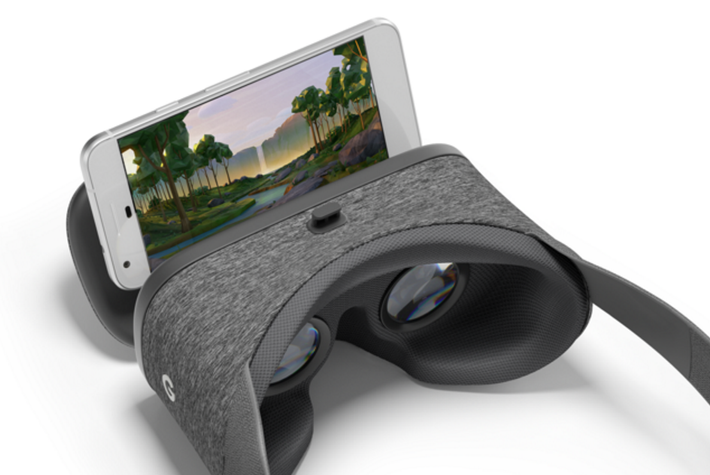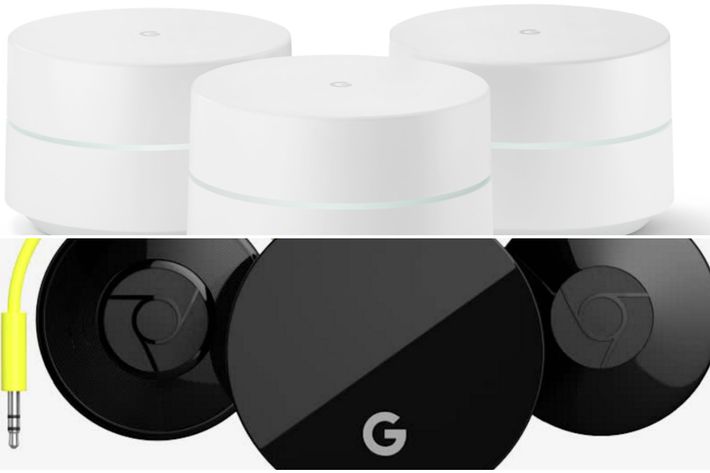
Google’s event today was ostensibly about showing off various new products — in particular, a quartet of hardware devices: a new phone, the Pixel; a new home-speaker device, Google Home; a new virtual-reality headset, the Daydream View; and a new Wi-Fi router. All of Google’s forays into hardware look intriguing, if not potentially best-in-class. But what people are going to really remember from the event is Google’s aggression, and not just because many of the presenters’ zingers were painfully bad.
The event was Google showing it wants not only to dominate search, mapping, web advertising, and email; it wants to own hardware as well. It clearly sees its own artificial-intelligence systems as the future, and ensuring that AI gets embedded everywhere means making openly aggressive moves against other hardware manufacturers.
Apple
Google started by throwing shade at Apple, and veered into “talking about your ex way too much” territory, taking potshots at Cupertino throughout its presentation of its Pixel phone, from pointing out that its camera didn’t protrude from the back of the phone (unlike Apple’s newest iPhones) to directly using Apple’s storage-warning screen while talking about the Pixel’s ability to use cloud storage to ensure your phone’s physical storage never fills up. The phone’s pricing exactly mirrors the iPhone’s (and breaks tradition with Google’s Nexus phones, which offered high-end hardware at budget prices), showing that Google believes it has a phone that can directly take on the iPhone.
Meanwhile, its demonstration of the new Google Assistant on the Pixel was a more indirect jab at Apple’s Siri, with a rundown of all the ways Google’s AI assistant can gather context and clues in ways that Apple simply can’t right now.
Finally, while the Google Home obviously is going after a space owned by Amazon so far, it’s also making the same play Apple is trying with HomeKit: provide a central hub for all of your smart home devices (including an upgraded Chromecast that now functions a lot like Apple TV, thanks to voice commands).
Amazon

Google Home is either directly inspired by the Amazon Echo (if you want to be kind) or a complete ripoff of it (if you don’t). But Google Home is also poised to be a better choice for anyone who hasn’t gotten an Echo. It costs less, $129 to the Echo’s $179, and Google Assistant is simply more powerful than Amazon’s Alexa, thanks to a much larger body of voice data to work with and its ability to follow conversations. It’ll be easier to use as well — installing new functionality on the Echo is a laborious process that you need to use your phone or laptop for, and the Echo will never be able to match Google when it comes to directions or keeping a daily calendar for you. Amazon has a jump on Google as the hub for smart home appliances, but Google seems to have already wrapped up the main players in the space (and, of course, has its own smart home offerings from Nest). The only thing that could hold Google Home back: Amazon is (wisely) refusing to sell it, the same way it has refused to sell Google’s Chromecast.
Behind the scenes, Google poached Amazon’s vice-president of product engineering, David Foster, just days before the event. Foster helped develop the Amazon Kindle, perhaps the most successful foray into hardware for Amazon, to the point where Kindle is a synonym for e-reader in the same way Google is a synonym for search. Foster will be heading up Google’s newly minted smartphone division.
Samsung

Poor Samsung. The best smartphone it had ever made started exploding, preventing it from perhaps overtaking the iPhone 7. Google’s Pixel is definitely aimed squarely at Apple, but it’s also poised to take on Samsung’s Galaxy S7 and S7 Edge as well — and stands a better shot of winning that fight, since migrating from a Galaxy S7 to a Pixel is relatively painless compared to switching from iOS to Android.
But the real stab to the heart for Samsung must be Google’s Daydream View VR headset, which is about as direct an answer to Samsung’s Gear VR as you can get. Google’s presentation was full of subtle digs at the Gear, from saying that they wanted a headset that was “like what people actually wear” to showing off that the Daydream headset worked wirelessly with any phone that meets Daydream specs, unlike Samsung’s offering, which only works with Samsung phones and requires you to (somewhat awkwardly) plug the phone into the headset before maneuvering it into place. The final touch: The Daydream View will be $79, versus the Samsung Gear VR at $99, and the Daydream will include a remote. The Gear has a helmet-mounted control pad, but handheld controllers cost extra.
Google and Samsung have had an uneasy alliance for years. In 2014, Google and Samsung had to hammer out a deal about how much Samsung could alter the Android OS. More recently, there have been rumors that Samsung wants to flee Android altogether for its own Tizen OS, already used for phones sold in India. With Samsung by far the largest manufacturer of Android smartphones (and thus carrying the suite of Google apps that help Google make money off distributing Android for free), a rift between the two would hurt both companies. But Google seems willing to chance it.
Eero, Luma, and Roku

Google’s hardware efforts will step on the toes of smaller players as well. Where in the past Google may have acquired a company, it’s now just putting out its own product.
Take Google’s Wi-Fi router’s mesh networking capabilities. For anyone trying to extend their Wi-Fi signal throughout their entire home, their options have largely been limited to ugly and difficult Wi-Fi extenders, or expensive solutions like Eero or Luma. Eero, for instance, does offer mesh networking, but it costs $499 for a pack of three. Luma, the closest competitor Eero had until now, comes in a three-pack for $399. A three-pack Google Wi-Fi routers will cost just $299.
Meanwhile, Roku, the upstart streaming set-top box company that showed the rest of the market how to make life simpler for cord cutters, has already seen Google sweep in with the Chromecast, which was the best-selling streaming solution in 2015. The newly announced Chromecast Ultra will now stream in 4K resolution and cost just $69. In what looks like a direct response, Roku announced that its own 4K streaming solution, the Roku Ultra (sensing a theme here), will offer $50 off its normal price of $130, bringing it almost into price parity with Google’s offering — though it will lack the ability to work in a smart home network the way Chromecast will.
Indeed, in every area except smartphones, Google seemed to look at the competitive space and offer a slightly better product at a slightly lower price point than what already exists in the market, a sign that Google perhaps isn’t that interested in making huge profits from its hardware, but simply getting Google hardware into consumers’ homes and hands (and thus using Google’s AI assistant). Companies facing this assault will have to choose: Either hope that their own offering is clearly a better one to dissuade price-sensitive shoppers from going the cheaper route, or lower their own prices to match Google’s. Google can almost certainly sustain selling hardware that makes little money or even acts as a loss leader, thanks to its deep pockets. Other companies may not be able to do the same.





























